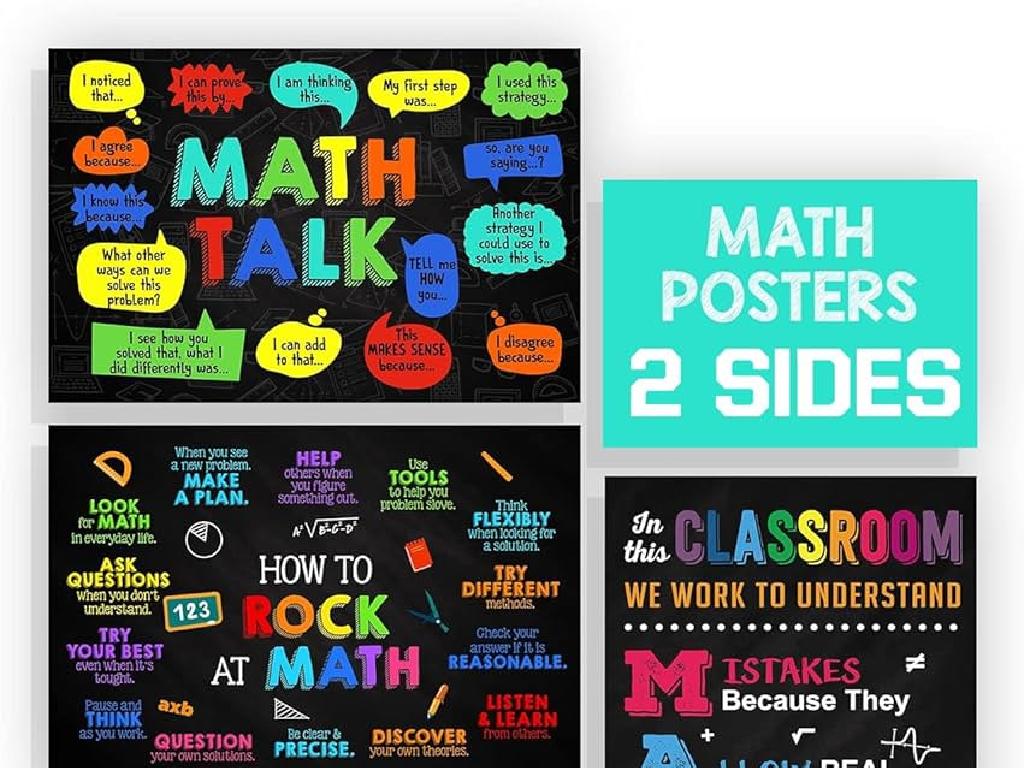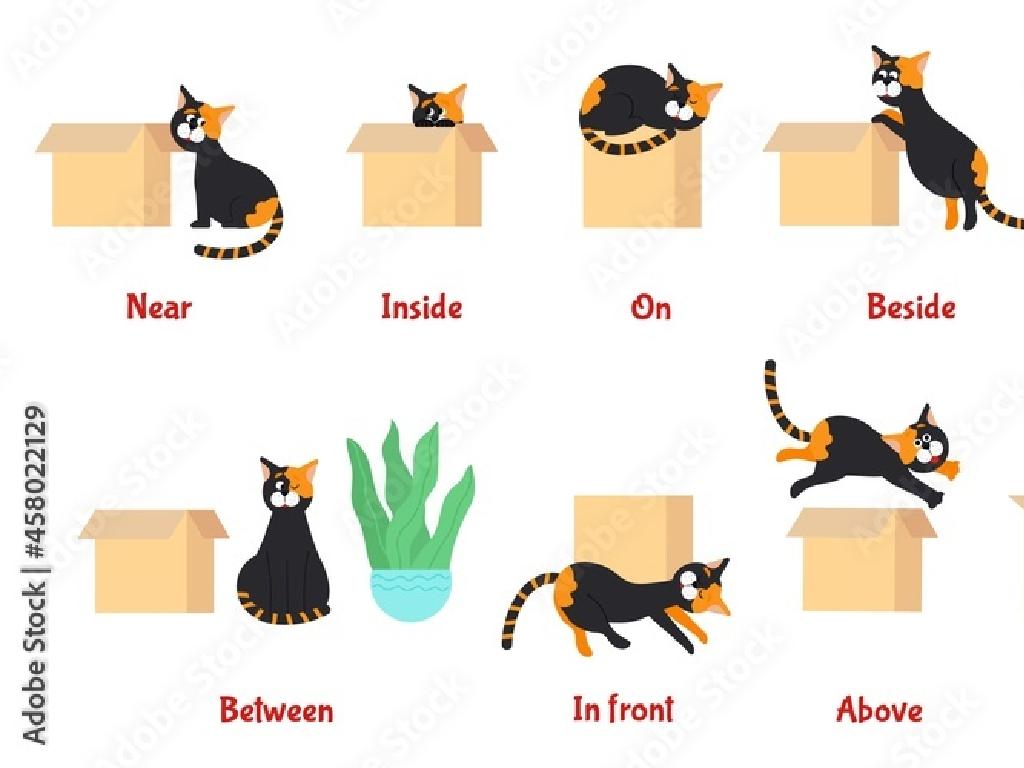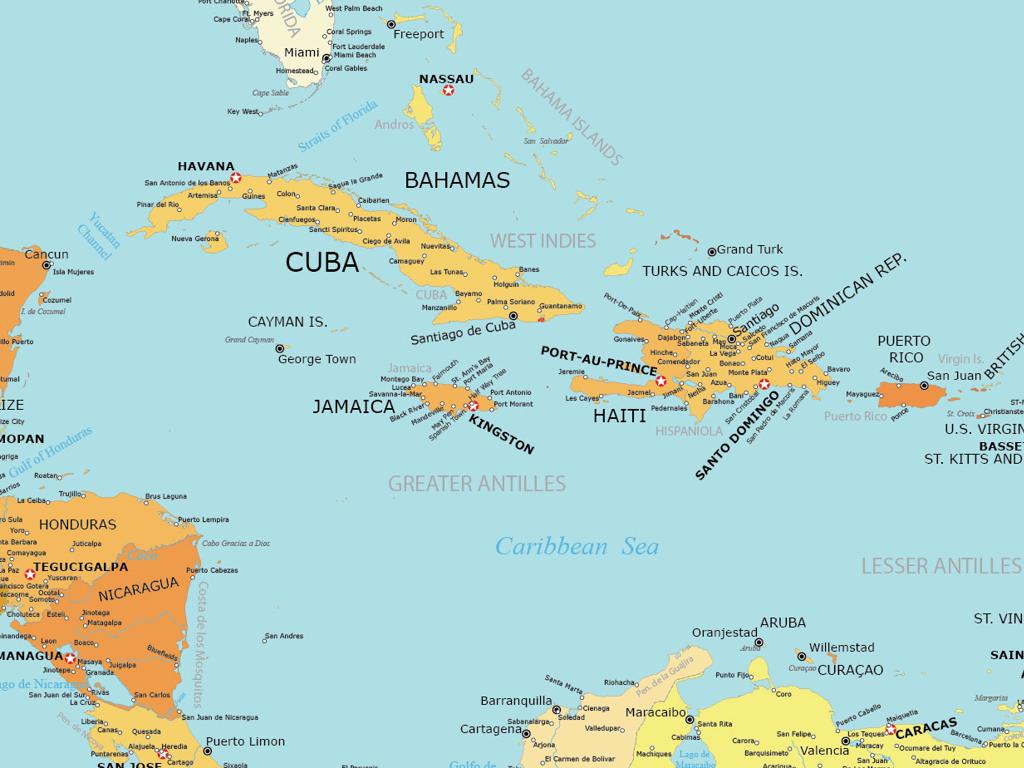Similar Triangles And Indirect Measurement
Subject: Math
Grade: Eighth grade
Topic: Transformations And Congruence
Please LOG IN to download the presentation. Access is available to registered users only.
View More Content
Exploring Similar Triangles
– Define similar triangles
– Triangles with same shape but different sizes, corresponding angles are equal, and sides are proportional.
– Real-life applications
– Use in architecture, art, and to measure distances that are difficult to reach directly.
– Indirect measurement technique
– Using proportions of similar triangles to find unknown distances or heights.
– Practice problems
|
This slide introduces the concept of similar triangles, which are triangles that have the same shape but may differ in size. Their corresponding angles are equal, and the lengths of their sides are proportional. This foundational understanding is crucial for recognizing how similar triangles are used in various real-life scenarios, such as in the fields of architecture, art, and even navigation. We’ll explore how indirect measurement, a technique that relies on the properties of similar triangles, can be used to determine distances or heights that are not easily measured directly. To solidify these concepts, students will engage with practice problems that apply these principles in real-world contexts.
Exploring Similar Triangles
– Define similar triangles
– Triangles with same shape but different sizes, angles are equal
– Properties of similar triangles
– Corresponding angles are equal, sides are proportional
– Triangle similarity criteria
– AA (Angle-Angle), SSS (Side-Side-Side), SAS (Side-Angle-Side) similarity
– Practical applications
|
This slide introduces the concept of similar triangles, which are triangles that have the same shape but may differ in size. The properties of similar triangles include equal corresponding angles and sides that are proportional. To establish similarity, students must learn the criteria: AA, where two angles of one triangle are equal to two angles of another; SSS, where the sides of one triangle are proportional to the sides of another; and SAS, where two sides are proportional and the included angle is equal. Understanding these concepts is crucial for solving problems involving indirect measurement and other real-world applications. Encourage students to practice identifying similar triangles using these criteria and to explore how this knowledge can be applied in practical scenarios.
Identifying Similar Triangles
– Use angles to confirm similarity
– If two triangles have the same angles, they are similar.
– Compare sides for proportional lengths
– Sides of similar triangles have the same ratios.
– Pair activity: Find similar triangles
– Work with a partner to identify similar triangles in various figures.
– Understanding triangle similarity
|
This slide introduces the concept of identifying similar triangles, a key component in understanding geometric relationships. Start by explaining that similar triangles have the same shape but not necessarily the same size, and this is determined by angle similarity and side proportionality. Demonstrate how to check for equal angles and proportional sides. For the class activity, provide pairs of students with sets of triangles to analyze and determine which are similar, guiding them to use the concepts of angle and side comparison. This hands-on practice will help solidify their understanding of the topic. Be prepared to offer hints and answer questions as students work through the activity.
Real-World Applications of Similar Triangles
– Architects and similar triangles
– Architects use them to create scale models and measure distances indirectly.
– Similar triangles in art
– Artists use them for perspective and proportion in their work.
– Similar triangles in daily life
– Spotting similar shapes in objects like pizza slices or road signs.
– Understanding practical geometry
|
This slide aims to show students how the concept of similar triangles is applied in various real-world scenarios. Architects use the principles of similar triangles to design buildings and structures, ensuring that different parts are in proportion. In art, understanding similar triangles allows artists to create realistic paintings and drawings with correct perspective. Everyday examples help students recognize these shapes in the world around them, reinforcing the idea that math is not just theoretical but also practical and ubiquitous. Encourage students to find their own examples of similar triangles in their environment to deepen their understanding.
Indirect Measurement with Similar Triangles
– Understanding indirect measurement
– It’s a technique to find a measure without direct measurement tools.
– Similar triangles in measurement
– If two triangles are similar, their corresponding sides are proportional.
– Example: Tree height via shadow
– Using a person’s height and shadow to calculate the tree’s height.
– Practical applications
|
Indirect measurement is a method used to calculate an unknown distance or length when direct measurement is not possible. This slide introduces the concept and its application using similar triangles, which are triangles with the same shape but different sizes. By understanding that corresponding sides of similar triangles are proportional, students can solve real-world problems, such as finding the height of a tree by comparing it to the length of its shadow and the height and shadow of a reference object, like a person. This method is particularly useful in situations where direct measurement is difficult or impossible. Encourage students to think of other scenarios where this technique could be applied.
Applying Similar Triangles and Indirect Measurement
– Solve similar triangle problems
– Use proportions to find missing sides
– Practice indirect measurement
– Apply ratios to real-life scenarios
– Group activity: Measure flagpole height
– Use shadows and proportions to estimate
– Discuss solutions and methods
|
This slide is aimed at reinforcing the students’ understanding of similar triangles and their application in indirect measurement. Start by solving problems that involve calculating missing sides of similar triangles using proportions. Then, move on to exercises that apply these concepts to indirect measurement in real-world contexts. For the group activity, students will work together to find the height of the school flagpole using the principles of indirect measurement, such as shadow lengths and proportions. After the activity, facilitate a discussion where students can share their methods and solutions, allowing them to learn from each other’s approaches. Provide guidance on setting up the proportion correctly and measuring accurately. This hands-on activity will help solidify their understanding of the mathematical concepts.
Class Activity: Measure and Calculate!
– Use shadows & similar triangles
– Find an object’s height indirectly
– Work in groups for measurement
– Measure shadow lengths and object’s height
– Present findings to the class
– Explain your calculation process
|
This hands-on activity is designed to help students understand the concept of similar triangles and how they can be used for indirect measurement. Students will use the shadows cast by an object on a sunny day to determine its height. They will work in groups to measure the length of the shadow and the height of a smaller, measurable object casting a similar shadow. Using the properties of similar triangles, they will then calculate the height of the taller object. After the activity, each group will present their findings, including the measurements taken and the calculations performed. Possible variations of the activity could include measuring different objects or using different methods to cast shadows. The teacher should ensure that students understand the mathematical principles behind the activity and guide them through the process of setting up the proportions correctly.
Conclusion: Similar Triangles & Indirect Measurement
– Recap of similar triangles
– Properties: equal angles, proportional sides
– Significance of indirect measurement
– Useful in real-world problems without direct measurement
– Engage in Q&A session
– Opportunity to address uncertainties
– Reinforce learning outcomes
|
This slide aims to consolidate the students’ understanding of similar triangles and the concept of indirect measurement. Begin by recapping the properties of similar triangles, emphasizing that they have congruent angles and sides in proportion. Highlight how indirect measurement is a practical application of similar triangles, allowing us to measure distances or heights that are difficult to measure directly. Encourage students to ask questions to clear up any confusion. Conclude by summarizing the key points to reinforce the learning outcomes of the lesson. This interactive session will help ensure students are confident in applying these concepts to real-life scenarios.





